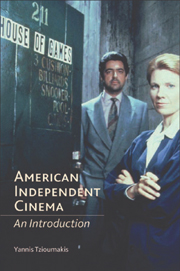Book contents
- Frontmatter
- Contents
- Analytical Table of Contents
- List of Tables
- List of Case Studies
- List of Figures
- Acknowledgements
- Dedication
- Introduction: Problems of Definition and the Discourse of American Independent Cinema
- Part I American Independent Cinema in the Studio Years (mid-1920s–late 1940s)
- Part II The Transitional Years (late 1940s–late 1960s)
- 3 Independence by Force: The Effects of the Paramount Decree on Independent Film Production
- 4 An Audience for the Independents: Exploitation Films for the Nation's Youth
- Part III Contemporary American Independent Cinema (late 1960s–present)
- Epilogue: From Independent to ‘Specialty’ Cinema
- Bibliography
- Index
3 - Independence by Force: The Effects of the Paramount Decree on Independent Film Production
from Part II - The Transitional Years (late 1940s–late 1960s)
- Frontmatter
- Contents
- Analytical Table of Contents
- List of Tables
- List of Case Studies
- List of Figures
- Acknowledgements
- Dedication
- Introduction: Problems of Definition and the Discourse of American Independent Cinema
- Part I American Independent Cinema in the Studio Years (mid-1920s–late 1940s)
- Part II The Transitional Years (late 1940s–late 1960s)
- 3 Independence by Force: The Effects of the Paramount Decree on Independent Film Production
- 4 An Audience for the Independents: Exploitation Films for the Nation's Youth
- Part III Contemporary American Independent Cinema (late 1960s–present)
- Epilogue: From Independent to ‘Specialty’ Cinema
- Bibliography
- Index
Summary
I have to know which [rules] I must abide by in order to safely break other ones … The trick is to be creative in how one abides by the rules.
Stanley Kramer, filmmakerIt's great to be left alone when you're making a movie, but not when you're finished with it!
James B. Harris, producerINTRODUCTION
The second period of the history of American independent cinema commences with the Paramount Decree of 1948, a consent decree the Big Five and Little Three studios signed when the US Supreme Court found them guilty of applying monopolistic practices that restrained trade and eliminated competition. The decision had a seismic impact on the structure of the American film industry as it forced the studios to divest themselves of their theatre chains and therefore lose control of exhibition, one of the three foundations upon which vertical integration depended. Although the studios found alternative ways to retain control of the film industry, the Paramount Decree became instrumental in gradually dismantling the studio system of production which had been at work since the late 1910s. Instead, the new system privileged a format of independent production which had its origins in the top-rank independent production model of the hyphenate filmmakers which had started gaining momentum during the 1940–8 period (see Chapter 1), though with some important differences. It could be argued that the Paramount Decree formalised the industry-wide shift to independent production that began in 1940 and therefore ushered in American cinema’s post-studio era.
- Type
- Chapter
- Information
- American Independent CinemaAn Introduction, pp. 101 - 134Publisher: Edinburgh University PressPrint publication year: 2006



